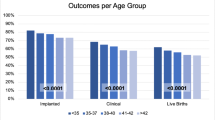Abstract
Purpose: To determine whether the relatively low implantation rate of cryopreserved Day 2 embryos with only 2 blastomeres can be increased as a consequence of increasing their blastomere content by extending the prefreeze culture time.
Methods: Of a total of 3480 Day 2 embryos studied, 1921 (55.2%) had reached the 4-cell stage by 40 h postinsemination (FAST) and were transferred or cryopreserved. The remaining embryos that underwent subsequent cell division by 46 h (INTERMEDIATE; 18.3% of total) or 66 h (SLOW; 20.3% of total) were also cryopreserved whereas the 6.2% that remained arrested at 66 h were discarded. Thawed embryos from each category were assessed for survival, postthaw cleavage, and implantation.
Results: The proportion of thawed embryos that survived, the proportion of surviving embryos that underwent postthaw cleavage, and the implantation rate of transferred embryos were all reduced in the slower growing cryopreserved embryos.
Conclusions: The growth rate, and not the number of blastomeres per se, is a critical factor in predicting the developmental potential of cryopreserved embryos.
Similar content being viewed by others
REFERENCES
Mandelbaum J, Belaisch-Allart J, Junca AM, Antoine JM, Plachot M, Alvarez S, Alnot MO, Salat-Baroux J: Cryopreservation in human assisted reproduction is now routine for embryos but remains a research procedure for oocytes. Hum Reprod 1998;13(Suppl 3):161-174;discussion 175-177
Jones HW, Jr, Out HJ, Hoomans EH, Driessen SG, Coelingh Bennink HJ: Cryopreservation: The practicalities of evaluation. Hum Reprod 1997;12:1522-1524
Cohen J: How to avoid multiple pregnancies in assisted reproduction. HumReprod 1998;13(Suppl 3):197-214;discussion 215-218
Edgar DH, Bourne H, Speirs AL, McBain JC: A quantitative analysis of the impact of cryopreservation on the implantation potential of human early cleavage stage embryos.Hum Reprod 2000;15:175-179
Ziebe S, Petersen K, Lindenberg S, Andersen AG, Gabrielsen A, Andersen AN: Embryo morphology or cleavage stage: How to select the best embryos for transfer after in-vitro fertilization. Hum Reprod 1997;12:1545-1549
Bourne H, Richings N, Harari O, Watkins W, Speirs AL, Johnston WI, Baker HW: The use of intracytoplasmic sperm injection for the treatment of severe and extreme male infertility. Reprod Fertil Dev 1995;7:237-245
Lassalle B, Testart J, Renard JP: Human embryo features that influence the success of cryopreservation with the use of 1,2 propanediol. Fertil Steril 1985;44:645-651
McKiernan SH, Bavister BD: Timing of development is a critical parameter for predicting successful embryogenesis. Hum Reprod 1994;9:2123-2129
Cummins JM, Breen TM, Harrison KL, Shaw JM, Wilson LM, Hennessey JF: A formula for scoring human embryo growth rates in in vitro fertilization: Its value in predicting pregnancy and in comparison with visual estimates of embryo quality. J In Vitro Fert Embryo Transf 1986;3:284-295
Burns WN, Gaudet TW, Martin MB, Leal YR, Schoen H, Eddy CA, Schenken RS: Survival of cryopreservation and thawing with all blastomeres intact identifies multicell embryos with superior frozen embryo transfer outcome. Fertil Steril 1999;72:527-532
Hartshorne GM, Wick K, Elder K, Dyson H: Effect of cell number at freezing upon survival and viability of cleaving embryos generated from stimulated IVF cycles. Hum Reprod 1990;5:857-861
Van der Elst J, Van den Abbeel E, Vitrier S, Camus M, Devroey P, Van Steirteghem AC: Selective transfer of cryopreserved human embryos with further cleavage after thawing increases delivery and implantation rates. Hum Reprod 1997;12:1513-1521
Ziebe S, Bech B, Petersen K, Mikkelsen AL, Gabrielsen A, Andersen AN: Resumption of mitosis during post-thaw culture:A key parameter in selecting the right embryos for transfer. Hum Reprod 1998;13:178-181
Edgar DH, Speirs AL, McBain JC: Strategies for embryo utilization in assisted reproduction-how do we assess their relative effectiveness? J Assist Reprod Genet 1999;16:460-461
Author information
Authors and Affiliations
Rights and permissions
About this article
Cite this article
Edgar, D.H., Jericho, H., Bourne, H. et al. CLINICAL ASSISTED REPRODUCTION: The Influence of Prefreeze Growth Rate and Blastomere Number on Cryosurvival and Subsequent Implantation of Human Embryos. J Assist Reprod Genet 18, 135–138 (2001). https://doi.org/10.1023/A:1009416205265
Issue Date:
DOI: https://doi.org/10.1023/A:1009416205265




